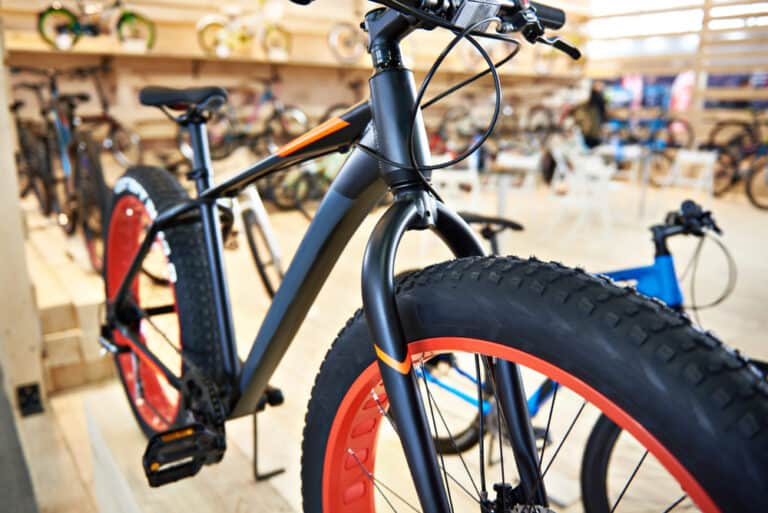Does Biking Burn More Calories Than Walking?

Many people often wonder if it’s better for them to cycle or to walk, as there are many similarities between biking and walking. Exercises that boost your metabolism are crucial for maintaining your health and vigor. Not everyone feels comfortable exerting additional effort for exercise. Biking and walking are both cardio exercises that will help you burn calories.
While both are beneficial, riding is superior to walking. For a given period, it consumes or burns more calories than walking. Because biking uses energy more effectively than walking, it is preferable to walking. Large muscle groups are used while you cycle, which burns more calories than walking.
Biking and walking are a favorite for many people as they get your heart rate going in a relatively simple way. Both have many benefits other than the calories they help you burn. Here’s all about biking and walking and how they affect weight loss, your general well-being, and how they compare when it comes to cost and convenience.
Which Burns More Calories, Biking Or Walking?
Generally, riding a bicycle burn calories approximately 2 times more calories than walking. For example, one hour of walking will result in you burning approximately 300 calories. In contrast, cycling will result in you burning twice as many calories per hour if you are cycling at a slow pace.
Let’s assume for the purposes of calculating that a workout will last 60 minutes. When it comes to biking, here’s what you can expect:
- Weight of person: 200lbs
- Brisk pace: 4 miles per hour
- Burned calories: 345 to 375 Kcal
Whereas with walking:
- Weight of person: 200lbs
- Fast pace: 15 miles per hour
- Burned calories: roughly 900 Kcal
Therefore, cycling is considered a much more effective form of exercise for burning calories. It’s essential to keep in mind that there is an additional element when it comes to biking. Most people may believe that they are getting the most out of a bike because they are traveling certain distances on it.
However, biking can be somewhat misleading when it comes to the calories being burned. In fact, if the pace is not being kept consistent or if you’re going 16 miles per hour, you aren’t exactly getting the most out of that ride. The effectiveness of biking can fluctuate depending on how the bike is being ridden.
Regarding biking, you would have to average those 15 miles cycling calories per hour for the duration of the ride. The only way that it is possible to get the consistency needed to average the miles will be if you are on a stationary bike or a bike path.
However, it’s safe to say that if you were to walk the same distance that you would bike, you would burn more calories during that walk simply due to the energy it’ll take you to travel whatever distance was traveled with the bike. For example, if you bike 10 miles and then walk the exact 10 miles you biked, you would burn more calories from those 10 miles walked than you would when biking 10 miles.
Keep in mind that it would take a long time to walk 10 miles and a shorter time to ride 10 miles. Typically, calories burned per unit of time differ. Biking burns more calories per unit of time than walking does. However, remember that you aren’t burning many calories when biking if you simply let the bike’s momentum propel you instead of paddling.
The number of calories that people can burn while walking vs biking depends on how hard they work out. Brisk walking, for instance, burns more calories than leisurely cycling. The number of calories the body burns also depends on things like height, weight, and mobility.
The additional resistance of pressing down on foot pedals when using a stationary bike causes it to burn more calories. To burn the extra calories, the stationary bike does this by concentrating on major muscle areas like the thighs and glutes.
Walking stimulates the calves, hip flexors, abdomen, and muscles along the front of the shins, in addition to exercising the same muscles as the stationary bike but at a lesser intensity. Holding light weights when pumping the arms while walking may help boost the total body fat burned and increase the calories burned.
Will You Lose Weight Faster Biking Or Walking?
Suppose you’re wondering which form of exercise between these two is better for weight loss. In that case, we have established that biking tends to burn double the calories walking burns. And as it is generally well-known that the more calories burned, the more weight you’ll lose, it’s no surprise that one may wonder if cycling is best for weight loss.
This is where it gets somewhat tricky. Weight loss typically comes with sustainability. The more you stay consistent with your exercise, the higher your chances of losing weight are in addition to eating well. Therefore, it isn’t just about how many calories does biking burn, which will, in turn, mean how much fat is burned.
At the fundamental level, the amount of weight you lose depends on calories consumed vs. calories burned. You must establish a calorie deficit in order to lose weight. This implies that if you eat too many calories, you’ll not lose weight even if you exercise a lot daily. Since 3,500 calories make up one pound of fat, you must burn 500 calories daily via a mix of diet and activity to lose one pound every week.
Cycling has more weight loss benefits than walking. Cycling has a considerably faster impact on metabolism, according to research. Furthermore, as is evidenced by the number of calories you burn when biking, if you are focused on weight loss more than anything, biking would work better at helping you reach your weight loss goal faster than walking.

Is Biking Or Walking Best For A Person’s General Well-Being?
Although you burn calories cycling, walking definitely has a leg up on cycling regarding your well-being. For example, although most people tend to not have the correct shoulders back posture when walking, it is better than the posture that a rider needs to maintain when biking.
In some cases, bikers often end up with back pain. The fact that biking mostly requires you to be hunched over to reach the handlebars isn’t healthy for the back. In comparison, rarely does walking ever lead to back pain.
Although the negligible injury rate is very low for walking and biking, bikes tend to have a bit of an upper hand as they have basically just about zero percent in impact since all you are doing is paddling. In contrast, walking has a tiny impact percentage as there is a minor crash when people take steps, certainly not anything to be worried about.
This is because there are benefits to the tiny impact that comes with walking. Research proves that these impacts can improve an individual’s heart health. This is because a vibration happens with each step, and these vibrations happen in the blood vessels. The vibrations do an excellent job of opening the blood vessels more, which in turn helps blood flow throughout the body.
With biking, it isn’t possible since you are paddling. Therefore, walking triumphs over biking to get your blood vessels to expand more than usual. Compared to biking, walking is less likely to result in stress injuries. Compared to biking, walking is also less likely to sustain accident-related injuries.
Cycling is good, but it’s less pleasurable as it puts more strain on the joints and requires fewer hand movements. Apart from being near nature, walking promotes whole-body activity and lessens joint stress. Cycling has less impact, so if your body gets used to it, extending workout sessions for longer lengths of time may be simpler.
Therefore, it may be superior in that regard as a calorie-burning workout. The intensity is more brutal to achieve until you are used to it, and it does have a higher skill need. Being primarily non-weight bearing, it is also not very effective at preventing the loss of bone density. The biggest benefit of walking is that it helps to strengthen your bones because of the impact pressures from your feet striking the ground.
Walking and biking both provide health advantages. Because biking uses energy more effectively than walking, it is preferable to walking. Large muscle groups are used while you cycle, which burns more calories than walking. Regular walking can assist in lowering blood pressure, building stamina, and reducing cholesterol levels.
Biking, on the other hand, may help prevent things like high blood pressure, dementia, diabetes, heart disease, depression, and also certain types of cancer. Walking is beneficial for you insofar as it maintains your heart rate high in a target training zone for a more extended period than biking, which takes anywhere between 15 and 30 minutes compared to 30 minutes to an hour of walking.
This depends on an individual’s pre-existing fitness level. Contrarily, biking will increase heart rate, perhaps too much for unfit people. Still, you’d finish the distance before you genuinely start benefiting yourself. Since walking is less efficient than cycling, you’ll likely exert more effort by walking quickly. This will also likely provide your lungs, heart, and major muscles more exercise.
Cost And Convenience Of Biking Vs. Walking
Cost is an essential aspect for many people when it comes to getting some exercise. Since many gyms cost an arm and a leg to join, few people have the finances to invest in equipment or build a homemade gym.
Therefore, it’s not surprising that many people are looking for aerobic exercise that is convenient and cost-effective. Walking is inexpensive; all you need are some clothes and shoes that fit you well. However, the same cannot be said for biking. Both the initial and ongoing costs of cycling exist.
The initial cost of getting a bicycle can be pretty hefty, especially if you’re looking for a good quality bike, depending on the make and model. Then there are other additional costs, such as safety gear. You will need a helmet in case any accidents happen.
Lights are also a good investment, particularly if you plan on biking in the early mornings or at night. Clothing is another expense that you will have to make provisions for. These are items like padded shorts, gloves, etc. You will also need to purchase a repair kit to have it handy for any potential accidents or injuries.
Let’s not forget the maintenance your bike will regularly need so it continues operating efficiently and in optimum condition. You’ll also need to keep in mind any potential part replacements. All of these costs are one of the reasons many prefer to walk instead. Walking is much more convenient as you can decide to go for a leisurely stroll.
If you want a more intense workout, you simply need form-fitting, comfortable clothes and running shoes. In contrast, biking requires you to get ready. You’ll need to fetch your bike and check that all is well with it. You’ll also need to get dressed in the appropriate gear. Biking can be considered convenient because it conveniently covers more ground in the same amount of time.
Conclusion
Biking and walking are activities that can improve your physical health and metabolism. Additionally, it can improve agility and stamina. When it comes to which one burns the most calories, biking triumphs over walking. This is not only because it leads to a more effective consumption of energy, but the muscles used when paddling help burn significantly more calories in the same amount of time.
However, as can be seen, walking takes the lead when it comes to general wellness. Walking has many health benefits despite the small impact created with every step taken. Those are regarding posture and back pain, bone strengthening, and enhanced blood vessel flows, and they are cheap and highly convenient. If you’re looking to burn calories, biking is better as it burns double the calories.






